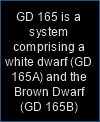Type L, T & Y Cool Brown Dwarf Stars
Class L Dwarf Stars
Cooler than Type M stars they have temperatures in the range 1,300K to 2,000K, and are typically a red-brown color. The classic example is GD 165B, which lacks the vanadium and titanium oxides of warmer type M dwarfs, but shows hydroxides. Although designated dwarfs, some can be rather large; for example, the rather mysterious star V838 Monocerotis could be the first type L supergiant. In a February 2002 eruption, it expanded to become more than 1,500 times the size of the Sun; it would reach to the orbit of Jupiter. Prior to the eruption, it was probably five to ten times the mass of the Sun, and up to five times the diameter. The reason for the eruption remains conjectural, and includes possibilities as diverse as an atypical nova, a merge with a much smaller star (a so-called Luminous Red Nova), or possibly engulfing large gas giant planets that had been in orbit. Based on the theory that the star was very young, perhaps only about four million years old, I find the gas giant hypothesis hard to swallow. The image to the right shows a sequence of photographs of the eruption in 2002 through to 2004. The shell of gas and dust is concave towards us. These stars are identified by metal hydride emission bands (FeH, CrH, MgH, CaH) and prominent alkali metal lines (Na I, K I, Cs I, Rb I). GD 165B is the prototype star of the "L" type dwarfs.
Class T Methane Dwarfs
Even cooler with surface temperatures in the range 700º to 1,300º K, they would appear as a dark magenta color. Not surprisingly, they have an abundance of Methane in their spectra. It is thought that there may be a huge number of these, and type L dwarfs, that we are unable to see. Their lifetimes tend to be incredibly long, for the light weight dwarfs, so numbers would continue to increase. The first identified was Gliese 229B, which orbits the red dwarf Gliese 229A. Its surface temperature is estimated to be below 1,000º K, and it weighs only about 2% to 5% the mass of the Sun, or about 20 to 50 times the mass of Jupiter. Remember, a candle flame is between 1,350 and 1,650º K or so! Gliese 229B is the smaller object in the image to the right orbiting its larger companion Gliese 229A. They are about 19 light years away. Gliese 229B is the prototype of the "T" type dwarfs. Their spectra are dominated by absorption bands from methane, and have very broad absorption features from the alkali metals Na and K. They also lack the FeH and CrH bands that "L" type dwarfs exhibit. Another example is the binary pair Epsilon Indi Ba (T1V) & Bb (T6V) which are in orbit around Epsilon Indi itself. Epsilon Indi Ba, the larger of the pair, weighs about 4.5% of the Sun, while it is about 9% the diameter, with a temperature of 1,280K. Epsilon Indi Bb, meanwhile, weighs about 2.7% of the Sun, while it is about 9.6% the diameter, with a surface temperature of only 850K. Both are similar in size to Jupiter, but much heavier and, therefore, denser. Image from The Gemini Observatory
Class Y Ultra-Cool Brown Dwarfs
This is a theoretical classification suggested for brown dwarfs that are even cooler than T dwarfs, at less than 600º K, and without the methane content. Until early 2011, no confirmed example had been identified. A very dim brown dwarf, with the catchy name UGPS J072227.51-054031.2, was a candidate, though it is currently defined as a type T10. It is about 13 light-years away, so in our stellar back yard, and was discovered in 2010. It is barely warm with a surface temperature around 480K to 560K (207º to 287º C or 405º to 549º F). About the same size as Jupiter, it weighs about 5 to 30 times as much, which is between about 0.5% and 3% the mass of the Sun; so cool and small. In March 2011, NASA announced that the smaller, and cooler, of a pair of brown dwarfs named CFBDSIR 1458+10 has a surface temperature of about 370K, the boiling point of water, and could well be a type Y. In fact, it is possible that it could have water clouds in its atmosphere. It is about 75 light-years away, and weighs about 5 to 15 times as much as Jupiter. The pair were imaged by the Keck telescope in Hawaii.
Shortly after the Keck announcement, NASA released information from the Spitzer telescope about an extremely cool brown dwarf star found about 63 light-years from Earth. It has only about seven times the mass of Jupiter, but the real surprise is that it appears to have a surface temperature of about 300K (30º C or 86º F); equivalent to a warm summer day. The star, WD 0806-661B orbits a white dwarf star known as WD 0806-661at a distance of 2,500 AU (nearly 375 billion km, or more than 230 billion miles). It is a strong candidate for being a Class Y star as are WISE 1828+2650 and WISE 0855-0714.
Credit: NASA/ESA
Astronomy & Cosmology
-
Stars - Stellar Classes






